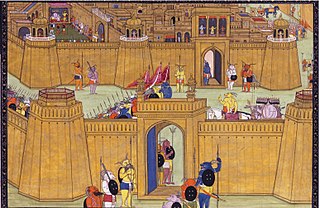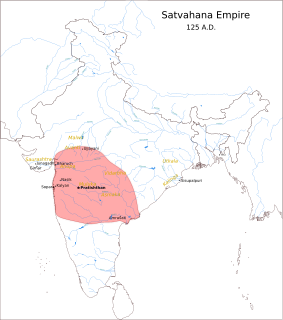Related Research Articles

Lanka is the name given in Hindu epics to the island fortress capital of the legendary asura king Ravana in the epics of the Ramayana and the Mahabharata. The fortress was situated on a plateau between three mountain peaks known as the Trikuta Mountains. The ancient city of Lankapura is said to have been burnt down by Hanuman. After its king, Ravana, was killed by Rama with the help of Ravana's brother Vibhishana, the latter was crowned king of Lankapura. The site of Lankā is identified with Sri Lanka. His descendants were said to still rule the kingdom during the period of the Pandavas. According to the Mahabharata, the Pandava Sahadeva visited this kingdom during his southern military campaign for the rajasuya of Yudhishthira.

The Middle kingdoms of India were the political entities in India from 200 BC to 1200 AD. The period begins after the decline of the Maurya Empire and the corresponding rise of the Satavahana dynasty, starting with Simuka, from 230 BC. The "Middle" period lasted for about 1,500 years and ended in 1200 AD, with the rise of the Delhi Sultanate, founded in 1206, and the end of the Later Cholas.

The history of southern India covers a span of over four thousand years during which the region saw the rise and fall of a number of dynasties and empires. The period of known history of the region begins with the Iron Age period until the 15th century CE. Dynasties of Chera, Chola, Pandyan, Chalukya, Pallava, Satavahana Rashtrakuta, Kakatiya, Reddy dynasty, Seuna (Yadava) dynasty and Hoysala were at their peak during various periods of history. These Dynasties constantly fought amongst each other and against external forces when northern armies invaded southern India. Vijayanagara empire rose in response to the Muslim intervention and covered the most of southern India and acted as a bulwark against Mughal expansion into the south. When the European powers arrived during the 16th and 18th century CE, the southern kingdoms, most notably Tipu Sultan's Kingdom of Mysore, resisted the new threats, and many parts eventually succumbed to British occupation. The British created the Madras Presidency which acted as an administrative centre for the rest of South India, with them being princely states. After Indian independence South India was linguistically divided into the states of Andhra Pradesh, Tamil Nadu, Karnataka, Telangana and Kerala.

The Pallava dynasty was an Indian dynasty that existed from 275 CE to 897 CE, ruling a portion of southern India. They gained prominence after the eclipse of the Satavahana dynasty, whom the Pallavas served as feudatories.

The Satavahanas, also referred to as the Andhras in the Puranas, were an ancient Indian dynasty based in the Deccan region. Most modern scholars believe that the Satavahana rule began in the late second century BCE and lasted until the early third century CE, although some assign the beginning of their rule to as early as the 3rd century BCE based on the Puranas, but uncorroborated by archaeological evidence. The Satavahana kingdom mainly comprised the present-day Andhra Pradesh, Telangana, and Maharashtra. At different times, their rule extended to parts of modern Gujarat, Madhya Pradesh, and Karnataka. The dynasty had different capital cities at different times, including Pratishthana (Paithan) and Amaravati (Dharanikota).

The Chutu dynasty ruled parts of the Deccan region of South India between first and third centuries CE, with its capital at Banavasi in present-day Karnataka state. The Chutus probably rose to power as Satavahanas feudatories, and assumed sovereignty after the decline of the Satavahana power. Except for the edicts of Asoka, the inscriptions of the Chutu dynasty are the oldest documents found in the northern part of Karnataka State, India.

The Vishnukundina dynasty was an Indian imperial power controlling the Deccan, Andhra Pradesh, Telangana, Odisha and parts of South India during the 5th and 6th centuries, carving land out from the Vakataka Empire. It played an important role in the history of the Deccan during the 5th and 6th centuries. The dynasty initially ruled from Indrapalanagara, and later shifted to Denduluru, and Amaravathi.
The Bruhat Palayanas were an ancient Indian dynasty based in the modern state of Andhra Pradesh. They ruled Northern Andhra with Pithunda, near Machilipatnam as the capital after the Ikshvakus around the third century. Jaya Varma was the only known Bruhatpalayana ruler. A princess of his family was married to the Andhra Ikshvaku king. His Kingdom included Musala Taluk as far as Gudivada, Kolleru and northern parts of Guntur. He gave the village of Patur in Tenali Taluk to eight Brahmins. After his death the Ananda Gotrikas occupied his territory to the south of the Krishna river and the Salankayanas took his territory north of the river.
The Telugu Chodas or Telugu Cholas ruled parts of present-day Andhra Pradesh between the sixth and the thirteenth century.
The Ikshvaku dynasty ruled in the eastern Krishna River valley of India, from their capital at Vijayapuri during approximately 3rd and 4th centuries CE. The Ikshvakus are also known as the Andhra Ikshvakus or Ikshvakus of Vijayapuri to distinguish them from their legendary namesakes.
This gives a timeline of major and important events that took place in the Guntur region of India.

Kishkindha is the kingdom of the Vanara King Sugriva, the younger brother of Vali, in the Sanskrit epic Ramayana. According to the historical account of India, this was the kingdom where Sugriva ruled with the assistance of his friend, Hanuman. This kingdom is identified to be the regions around the Tungabhadra river near Hampi in present-day Vijayanagara district, Karnataka. The mountain near the river known as Rishimukha, where Sugriva lived with Hanuman during his exile, bears the same name.

Andhra Pradesh is one of the 28 states of India, whose recorded history begins in the Vedic period. It is mentioned in Sanskrit epics such as Aitareya Brahmana. The Assaka Mahajanapada was an ancient kingdom located between the Godavari and Krishna Rivers in southeastern India.

The Eastern Ganga dynasty also known as Rudhi Gangas or Prachya Gangas were a large medieval era Indian royal dynasty that reigned from Kalinga from as early as the 5th century to the early 15th century. The territory ruled by the dynasty consisted of the whole of the modern-day Indian state of Odisha as well as major parts of West Bengal, Andhra Pradesh and Chhattisgarh. The early rulers of the dynasty ruled from Dantapuram; the capital was later moved to Kalinganagara, and ultimately to Kataka . Today, they are most remembered as the builders of the world renowned Puri Jagannath Temple and Konark Sun Temple, a UNESCO World Heritage Site at Konark, Odisha.
The Banas were a dynasty of South India, who claimed descent from kingMahabali. The dynasty takes its name from Bana, the son of Mahabali. The Banas faced opposition from several neighbouring dynasties and served some major dynasties such as the Cholas and Pandyas as feudatories, sometimes after they were subjugated by them. They also served as Samantas to some dynasties such as Chalukyas. The Banas had their capital at various places at different times, including Kolar and Gudimallam. The earliest mention of the Banas in authentic historical records is in the middle of the fourth century AD, and as the feudatories of the Satavahana and early Pallavas.
Poosapati / Pusapati was the ruling clan of the Northern Andhra region, Vizianagaram.

The Chalukya dynasty was a Classical Indian dynasty that ruled large parts of southern and central India between the 6th and the 12th centuries. During this period, they ruled as three related yet individual dynasties. The earliest dynasty, known as the "Badami Chalukyas", ruled from Vatapi from the middle of the 6th century. The Badami Chalukyas began to assert their independence at the decline of the Kadamba kingdom of Banavasi and rapidly rose to prominence during the reign of Pulakeshin II. After the death of Pulakeshin II, the Eastern Chalukyas became an independent kingdom in the eastern Deccan. They ruled from Vengi until about the 11th century. In the western Deccan, the rise of the Rashtrakutas in the middle of the 8th century eclipsed the Chalukyas of Badami before being revived by their descendants, the Western Chalukyas, in the late 10th century. These Western Chalukyas ruled from Kalyani until the end of the 12th century.
The Mathara dynasty ruled in the Kalinga region of eastern India during 4th and 5th centuries CE. Their territory included parts of the area between the present-day Ganjam district of Odisha and the Srikakulam district in Andhra Pradesh. They appear to have been overthrown by the Pitrbhakta dynasty.
Gosahasra or go-sahasra-dana is a ritual donation described in the ancient texts of India. It is one of the sixteen great gifts (shodasha-mahadana), and is frequently mentioned in the ancient inscriptions.
Madhava Varma II, He is the Most Powerful King of Vishnukundina dynasty. The reign of Madhava Varma II was a golden age in the history of the Vishnukundinas. He is regarded as the greatest ruler of his dynasty. The Vishnukundina Empire reached its greatest territorial extent under him. He defeated Prithvishena II, the powerful Vakataka king. The daughter of Prithvishena II, Vakataka Mahadevi, was given in marriage to Madhava Varma II.
References
- 1 2 3 4 5 6 7 Sen, Sailendra Nath (1999). Ancient Indian History and Civilization. New Age International. p. 433. ISBN 9788122411980.
- ↑ Lakshmanna, Chintamani (1973). Caste dynamics in village India. Nachiketa Publications. p. 27.